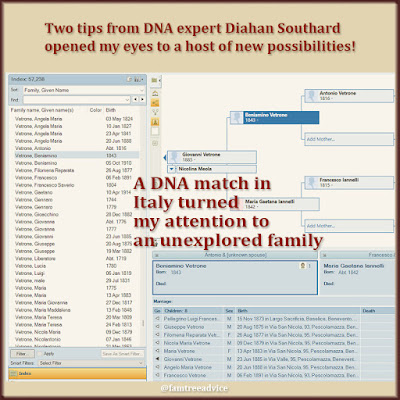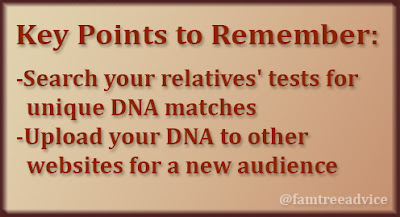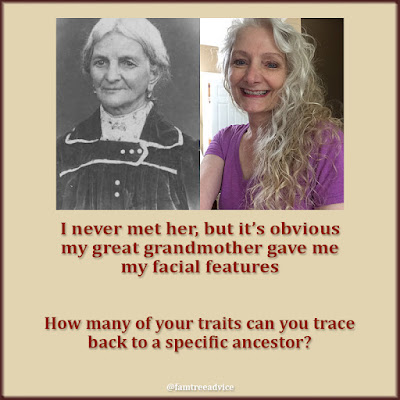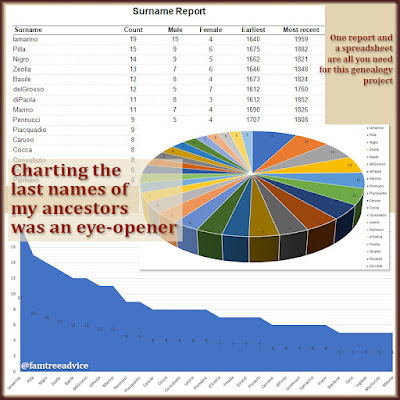On Friday I finished an ambitious family tree project I started in January. I've been working at it nearly every day, and it was worth it. I've truly fortified my family tree. (See "Take the Time to Improve the Sources in Your Family Tree.")
I reviewed and perfected every single source citation in my enormous family tree! (If you don't have 57,125 people in your tree, you can do this in a lot less time.) The project's two goals were to:
- Use a consistent style for each type of source citation. I started building my family tree about 20 years ago, so the older citations had almost no detail. It took me a while to develop my style.
- Fix a problem that was happening behind my back. My last laptop was a nightmare. I blame it for most of my failed syncs between Family Tree Maker and Ancestry.com. Those failures were splitting and duplicating my citations. Normally I'll create a citation and share it among all the appropriate family members' facts. But the failed syncs split the citation into 10 citations for 10 family members. This bulked my tree's file size up to 5 gigabytes. It would take forever to save, to back up, to compact, and to store away.
 |
| An accident duplicated my source citations and fattened up my family tree file to 15 times its regular size. Here's how I fixed everything. |
At the end of this project, I cut my tree's file size down to a fifteenth of what it was. Instead of 5 gigabytes, it's 366 megabytes. On my new computer, my tree takes only a moment to save. And copying the file to a backup location takes a second. Plus, I know my source citations are "clean enough to eat off of."
How to Make Your Citations Shine
Online-only Tree. If you build and store your family tree online only, your goal is to add citations where there are none. You can't access your citations in one place or share one well-crafted citation with a family.
See if you can access an alphabetical list of everyone in your tree. On Ancestry, go to your tree and click the Tree Search button at the top right. Choose List of all people. Now check each person to see who has facts without sources. Then find the sources! Keep a running list somewhere so you always know where you left off for the day. If your family tree is a normal size, this approach will work for you.
Desktop Tree. If you build your family tree using a desktop program, you can be a lot more efficient. You should have a tab that brings all your citations together, listing them by source title. In Family Tree Maker, I can see on the Sources tab that I have 327 source titles, 87 of which are individual towns in Italy. Apart from Italy, most of my sources are census and immigration records.
I began with the censuses, from the 1851 England Census through the 1950 U.S. Federal Census. For each one, I reviewed each source citation, one at a time. First I went to the head of household in my family tree and opened the census image. Then I found the original record online. (My sources are from Ancestry mostly, with a small number from FamilySearch.) I gathered the details I needed for my source citation. I shared the citation with every appropriate fact and deleted duplicates.
For each type of source, I have a format I stick to. In general, I copy the suggested citation from Ancestry or FamilySearch. (See "Choosing and Using the Most Reliable Sources.") Then I paste the entire citation, plus several more details, into the image's details. Now the image itself tells me where it came from.
With a census or ship manifest, I add the appropriate line number(s). For a census, I spell out the:
- enumeration district
- supervisor's district
- city ward
- sheet number
- image number online
Here's how the citation looks for a particular 1930 U.S. Federal Census:
- Source title: 1930 U.S. Federal Census
- Citation detail: Year: 1930; Census Place: Bronx, Bronx, New York; Page: 13B; Enumeration District: 0070; FHL microfilm: 2341200
- Citation text: Ancestry.com. 1930 United States Federal Census [database on-line]. Provo, UT, USA: Ancestry.com Operations Inc, 2002.
- Original data: United States of America, Bureau of the Census. Fifteenth Census of the United States, 1930. Washington, D.C.: National Archives and Records Administration, 1930. T626, 2,667 rolls.
- Web address: https://www.ancestry.com/discoveryui-content/view/30164368:6224
And here's what I put in the image's details:
- lines 75-81; 1930 United States Federal Census; New York > Bronx > Bronx (Districts 1-250) > District 0070; enumeration district 3-70, supervisor's district 25, assembly district 2, block I, sheet 13B; image 25 of 35
- https://www.ancestry.com/discoveryui-content/view/30164368:6224
- Source Citation: Year: 1930; Census Place: Bronx, Bronx, New York; Page: 13B; Enumeration District: 0070; FHL microfilm: 2341200
- Source Information: Ancestry.com. 1930 United States Federal Census [database on-line]. Provo, UT, USA: Ancestry.com Operations Inc, 2002.
- Original data: United States of America, Bureau of the Census. Fifteenth Census of the United States, 1930. Washington, D.C.: National Archives and Records Administration, 1930. T626, 2,667 rolls.
Note that the web address I record is not the URL of the image itself. It's the URL of the record on Ancestry. The record provides a link to the image, key details, source info, and a list of related documents for the same person.
By working on all the census citations one after another, you'll get very familiar with the format. You'll gain efficiency and consistency.
After all the census citations, I worked on a bunch of sources with small numbers of citations:
- birth and marriage records from Derbyshire, England
- immigration records from Hawaii and Florida
- death records from Ohio and Pennsylvania, and so on.
I wanted to pick off smaller sources before attacking my Ellis Island ship manifests. That's a trick I always play on myself. I'd rather complete 20 source titles than get stuck in a big one, knowing all those others are waiting for me.
 |
| Work on perfecting the source citations in your family tree one type at a time. You'll gain consistency and efficiency as you add value. |
After removing duplicates, I have 246 Ellis Island citations in my family tree. I built each citation using the same, consistent format. As I explained above, I copy the suggested citation from Ancestry and add it, along with extra details, to the image.
But I still had my 87 different Italian towns' citations to fix. My Italian document images all come from the Antenati website. The website changed dramatically in 2021, leaving my citations with broken URLs. And the duplication in my tree was insane.
I worked my way through the towns saving the biggest ones for last. These were my closest ancestors' hometowns. My primary town, Colle Sannita, started with more than 7,700 citations, but I saw tons of duplicates. Now that it's all finished, I have 3,377 citations.
My citation format for the Italian vital records is designed to help you find it in the Italian archives or online. It looks like this:
From the Benevento State Archives, 1809 matrimoni, Colle Sannita, document 1, image 3 of 15 at https://antenati.cultura.gov.it/ark:/12657/an_ua1113932/5VNQENO
Here's the same format showing which variables you need to plug in:
From the PROVINCE State Archives, YEAR and DOCUMENT TYPE, TOWN, document #, image # of # at URL
Having done all this, my family tree is SO CLEAN! All my earliest sub-par work is now completely up to my high standards. And I know I'll never again go on a spree adding facts and documents without perfect citations.
I've been working full-throttle on my tree for a long time. I'm growing it by leaps and bounds as I explore the vital records from my ancestral hometowns. But that's been on pause all year for this clean-up project. Now my 57,125-person family tree will start growing like crazy again. But always with perfect source citations.










